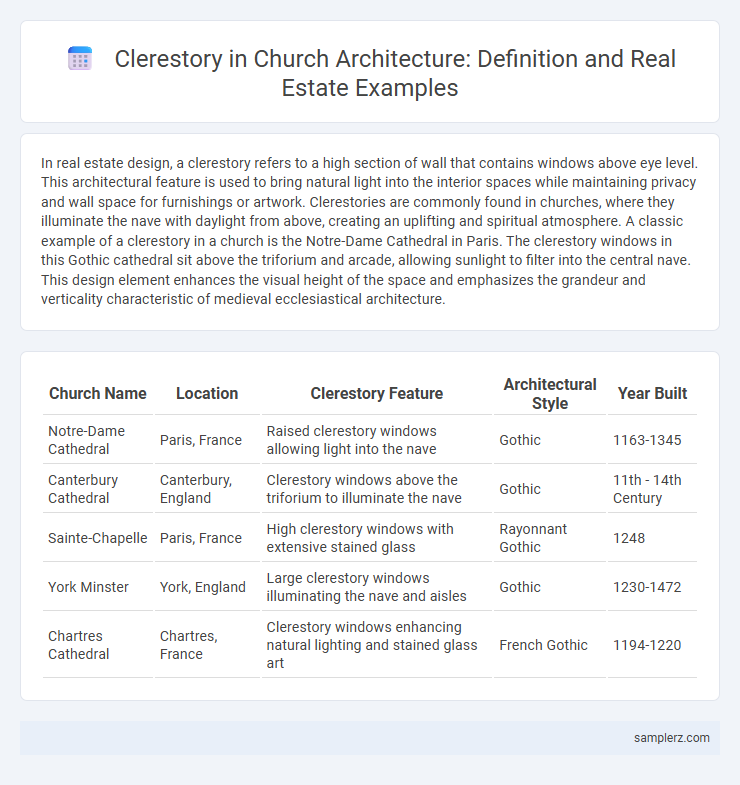In real estate design, a clerestory refers to a high section of wall that contains windows above eye level. This architectural feature is used to bring natural light into the interior spaces while maintaining privacy and wall space for furnishings or artwork. Clerestories are commonly found in churches, where they illuminate the nave with daylight from above, creating an uplifting and spiritual atmosphere. A classic example of a clerestory in a church is the Notre-Dame Cathedral in Paris. The clerestory windows in this Gothic cathedral sit above the triforium and arcade, allowing sunlight to filter into the central nave. This design element enhances the visual height of the space and emphasizes the grandeur and verticality characteristic of medieval ecclesiastical architecture.
Table of Comparison
| Church Name | Location | Clerestory Feature | Architectural Style | Year Built |
|---|---|---|---|---|
| Notre-Dame Cathedral | Paris, France | Raised clerestory windows allowing light into the nave | Gothic | 1163-1345 |
| Canterbury Cathedral | Canterbury, England | Clerestory windows above the triforium to illuminate the nave | Gothic | 11th - 14th Century |
| Sainte-Chapelle | Paris, France | High clerestory windows with extensive stained glass | Rayonnant Gothic | 1248 |
| York Minster | York, England | Large clerestory windows illuminating the nave and aisles | Gothic | 1230-1472 |
| Chartres Cathedral | Chartres, France | Clerestory windows enhancing natural lighting and stained glass art | French Gothic | 1194-1220 |
Introduction to Clerestory Architecture in Churches
Clerestory architecture in churches features high walls with rows of windows placed above eye level, allowing natural light to flood the nave and illuminate the interior space. This design element enhances the spatial volume and creates an uplifting atmosphere, often seen in Gothic and Romanesque church structures. Incorporating clerestory windows increases both aesthetic appeal and energy efficiency by reducing the need for artificial lighting.
Historical Significance of Clerestory Windows in Sacred Spaces
Clerestory windows in historical churches allowed natural light to illuminate sacred interiors, enhancing spiritual ambiance and architectural grandeur. These elevated openings played a crucial role in Gothic and Romanesque designs, symbolizing divine presence and elevating the viewer's gaze. Real estate professionals recognize the enduring aesthetic and cultural value clerestory windows contribute to heritage properties, increasing both historical significance and market appeal.
Early Christian Churches Featuring Clerestory Designs
Early Christian churches prominently featured clerestory designs, with elevated windows positioned above eye level to enhance natural lighting and ventilation in expansive interiors. Notable examples include the Basilica of San Clemente in Rome and the Basilica of Saint Paul Outside the Walls, where clerestory windows illuminate the nave, creating a serene and spiritual atmosphere. This architectural element influenced subsequent church constructions, emphasizing both functional light distribution and aesthetic grandeur in sacred spaces.
Notable Examples of Medieval Clerestory Churches
Notable examples of medieval clerestory churches include Chartres Cathedral in France, renowned for its elevated windows that flood the nave with natural light, and Canterbury Cathedral in England, which features a distinctive clerestory that enhances the Gothic architectural style. Lincoln Cathedral also showcases an impressive clerestory level, contributing to its soaring interior and structural stability. These churches exemplify the use of clerestories to create spacious, illuminated interiors, a concept influential in both historical and modern real estate design.
Structural Elements of Clerestory in Gothic Cathedrals
Clerestory windows in Gothic cathedrals serve as elevated openings that allow natural light to penetrate the nave beneath the vaulted ceiling, enhancing the spatial experience. These structural elements typically rest above the aisle roofs and are supported by flying buttresses, which counterbalance the lateral forces exerted by the vaulted ceilings. The intricate tracery and pointed arches characteristic of Gothic design maximize window size while preserving the structural integrity of the lofty walls.
Iconic Churches with Impressive Clerestory Windows
Iconic churches like Notre-Dame de Paris and Sainte-Chapelle showcase impressive clerestory windows that flood interiors with natural light and enhance architectural grandeur. These elevated windows serve both aesthetic and functional purposes, creating a serene atmosphere that complements the sacred space. Real estate developers often draw inspiration from such historic designs to incorporate clerestory features in modern luxury properties, adding both elegance and increased daylighting.
Impact of Clerestory Lighting on Church Interiors
Clerestory lighting in church interiors enhances natural illumination, reducing reliance on artificial light sources and creating a serene ambiance that highlights architectural features. This design element improves the visual connection between congregants and the spiritual environment by filling the space with diffused daylight. Real estate developers specializing in historical or religious properties prioritize clerestory windows to maintain authenticity while optimizing energy efficiency and aesthetic appeal.
Regional Variations in Church Clerestory Construction
Church clerestory designs exhibit distinct regional variations shaped by local climate, materials, and architectural traditions. In Mediterranean regions, clerestories often feature large, arched windows to maximize sunlight and ventilation, while Northern European churches tend to have narrower, vertical openings to preserve heat. These regional adaptations influence the overall aesthetic and lighting quality, impacting the property's historical and cultural value in real estate assessments.
Preservation and Restoration of Clerestory Features in Churches
Preservation and restoration of clerestory features in churches enhance natural lighting while maintaining architectural integrity, with emphasis on repairing original stained glass and wooden frames. Methods include using historically accurate materials and employing skilled artisans to replicate intricate designs for authenticity. Maintaining clerestory elements not only protects heritage but also increases property value in the real estate market.
Modern Interpretations of Clerestory in Contemporary Church Design
Modern interpretations of clerestory windows in contemporary church design emphasize natural light and energy efficiency, integrating large, high-placed glass panels that create an uplifting spiritual atmosphere. These architectural features utilize advanced glazing technologies to enhance daylight distribution and reduce the need for artificial lighting. Contemporary churches often blend minimalist aesthetics with traditional clerestory elements, promoting both visual connection to the heavens and sustainable building practices.

example of clerestory in church Infographic
 samplerz.com
samplerz.com